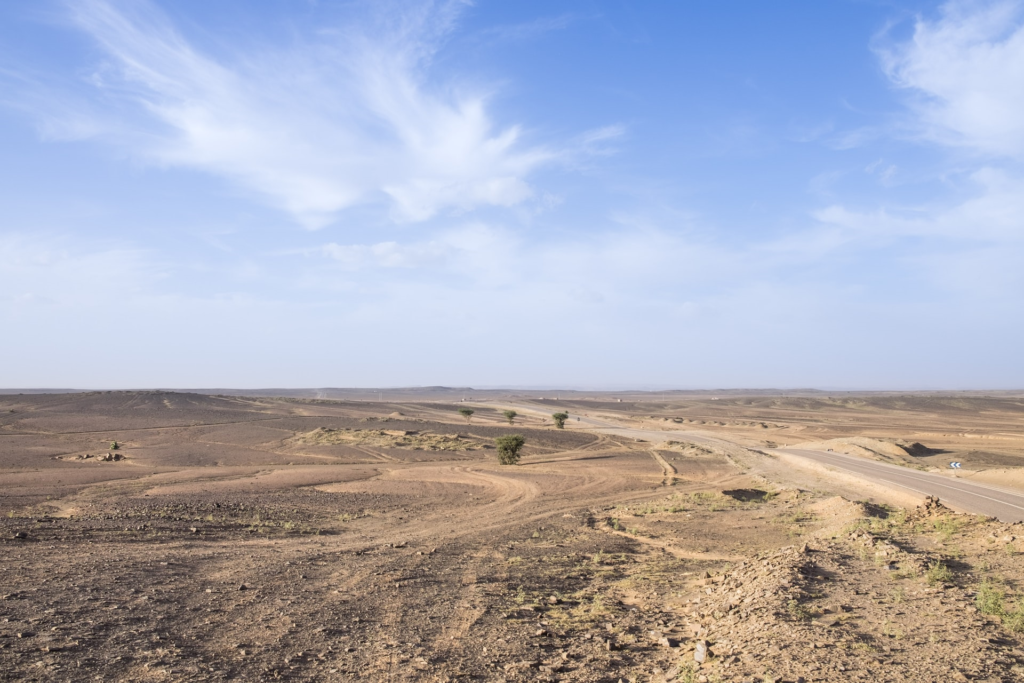Cold deserts are often sub-divided into Cold and Coastal types.
Cold Desert Ecosystems
Cold deserts are found in the Antarctic, Greenland, Northern and Western China, Turkestan, Iran and the Nearctic area. Many nomads have settled on farms in the Gobi Desert and it was crossed as early as the 13th century by Genghis Khan. Cold deserts can also be found in certain mountainous areas, such as the Great Basin area of western United States.
Deserts in this category have the following characteristics:
- Large amount of snowfall in winter (and sometimes in summer), plus a high average of rainfall (15-26 cm.) occurring mainly in April and May or autumn, depending upon the area
- Short, wet moderately warm summers
- Mean average winter temperature -2 to 4ºC
- Mean average summer temperature 21-26º
- Heavy, relatively porous soil with a lot of silt and salt
- Good drainage to leach out most of the salt
Animal Adaptations
Deer inhabit some of these areas only in winter, having grown a thick fur coat, and then migrate in the summer season, after shedding this coat.
Small mammals such as kangaroo rats, kangaroo mice, pocket mice, grasshopper mice, antelope ground squirrels, badger, kit fox and coyote, as well as several lizards, all dig burrows to wait out the cold weather.
Gazelles, jack rabbits, gerbils, saiga antelope, wolves, sidewinder and viper snakes desert tortoises, lizards are but a few examples of animals who are active in the early morning (fossorial) and who seek shelter during the hottest part of the day, either in burrows or in the shade of plants.
Plant Adaptations
Two examples of heavy salt concentrations are the Great Salt Lake of the western United States and Iran, Aghanistan and Pakistan.
Plants can vary from heights between 15 cm and 122 cm, depending upon the area. Most shed their leaves (deciduous) and have spiny leaves. Ground cover such as lichens, are found in areas such as Torgerson Island, Antarctica and cover much of the ground, whereas in other areas the plants are found quite apart from each other.
Some examples of plants found in cold deserts include grasses, shadscale and camel’s thorn.
Coastal Desert Ecosystems
Coastal deserts are found in cool to warm areas such as parts of the Arctic and temperate areas of Greenland & North America (Nearctic), as well as parts of Central America, South America and the Caribbean (Neotropical). One example is the Atacama area of Chile, where farmers carry out a subsistence lifestyle in one of the driest areas found on earth. The Namib Desert in Southwest Africa is the world’s greatest source of gemstones.
Deserts in this category have the following main characteristics:
- Cool winters (average is 5ºC or lower) followed by moderately long, warm summers (average is 13-24ºC)
- Average rainfall is 8-13 cm (maximum 37cm, minimum 5cm)
- Moderate salt content
- Fine-textured porous soil or sand
- Good drainage
Animal Adaptations
Similar to those animals living in Hot Desert areas, animals in the Coastal Area have evolved specialized methods of dealing with the heat and lack of water.
Some toads burrow down in the soil, secreting a jelly-like shield around itself, remaining inactive for up to nine months until the next heavy rainfall. Other amphibians accelerate their life cycle through the larval stage, improving their chances of survival while water is available.
Insects and fairy shrimp, too have adapted by laying eggs that remain dormant until there is rainfall to provide sustenance for the hatchlings.
Mammals such as coyote and badger, as well as amphibians, lizards and snakes spend the hot part of the day in burrows.
The great horned owl is mainly nocturnal, thus avoiding the heat of the day, but it can also cool itself by opening its beak and fluttering its throat area. Golden eagle and bald eagle soar high above their habitat, finding cooler temperatures. Other birds migrate to cooler climates when it becomes too hot.
Plant Adaptations
In the coastal Deserts, some plants have surfaces that are corrugated with ridges and grooves, such as salt bush, rice grass, black sage, etc. During rainfall the stem swells so that the grooves are far apart; as the water is used up the stem shrinks.
Other plants found in Coastal deserts include bunchgrass, cardon cactus, aloe, bunchgrass, lichens.
Effects of Global Warming on Cold Deserts
On one hand, deserts are very vulnerable because of:
- Declining rainfall of 5 to 15% (Australia’s Great Victoria desert, the Atacama and the Colorado Great Basin)
- Paradoxically areas such as the Gobi will experience a 10-15% increase in rainfall
- An average of an increase of 3ºC in air temperature annually
- Diversion of large rivers that cross deserts to provide water to nearby cities and farms
- Construction of roads, settlement expansion and other development in nearby areas
- Desert plants are a potential source of new medicines and have not yet been explored in depth. Global warming may well destroy this untapped possible source of anti-cancer and anti-malarial compounds
On the other hand, adjacent areas are also vulnerable because of
- Increase in winds that will pick up sand grains off the dunes and deposit them in vegetated areas, thus turning these now arable areas into desert. The continent of Africa is increasingly being affected
- Damming of the large rivers that cross deserts cause downstream water supplies to dry up, having a serious impact on flood plains and river ecology
- Rising water tables underneath the irrigated soils are prone to contamination due to increase in salt content as seawater seeps into underground water.




